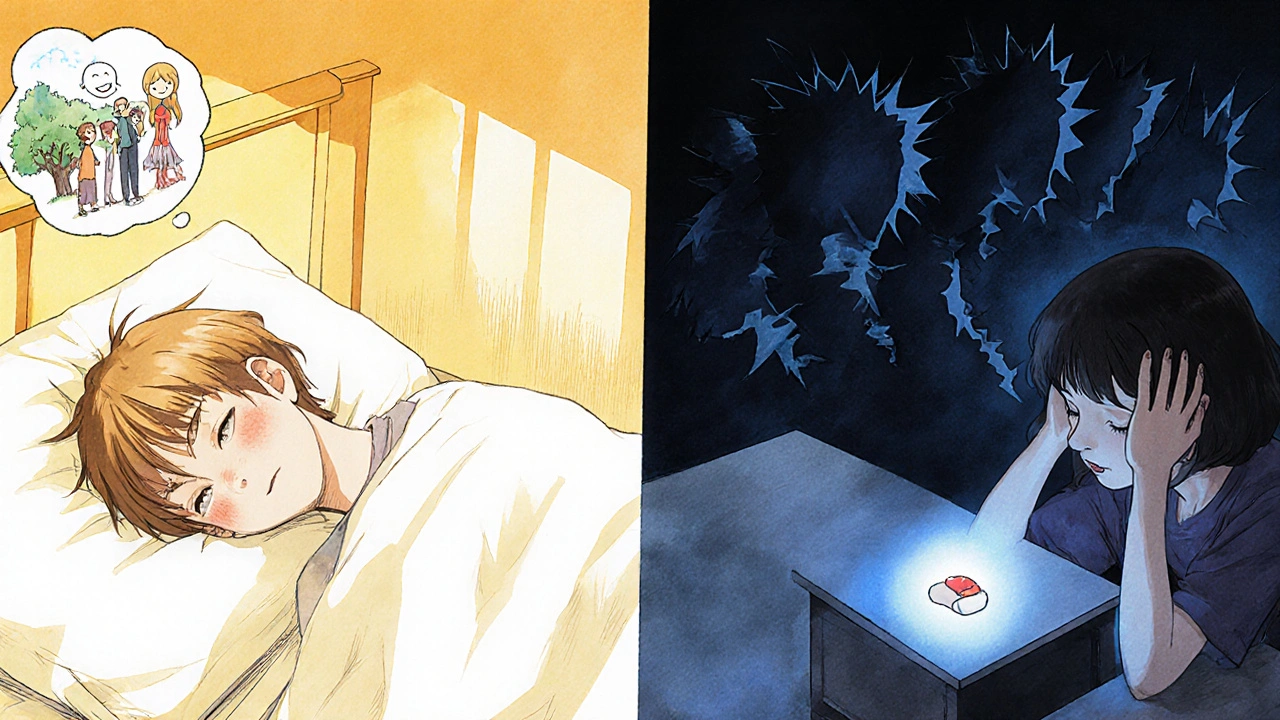Olanzapine is a medication used primarily to treat schizophrenia and bipolar disorder. It doesn’t cure these conditions, but it helps manage symptoms like hallucinations, delusions, extreme mood swings, and disorganized thinking. Millions of people worldwide take it daily, often as part of a longer-term treatment plan. But it’s not a simple pill to just pop and forget-understanding how it works, what to expect, and how to stay safe matters more than most people realize.
How Olanzapine Works in the Brain
Olanzapine belongs to a class of drugs called atypical antipsychotics. Unlike older antipsychotics that mainly blocked dopamine, olanzapine affects multiple brain chemicals at once-primarily dopamine and serotonin. This dual action helps reduce psychotic symptoms without causing as many movement-related side effects as older drugs like haloperidol.
Think of your brain as a control room with too many alarms going off at once. In schizophrenia or mania, the signals get mixed up. Olanzapine doesn’t silence the alarms completely, but it turns down the volume enough so the brain can function again. That’s why people often report feeling calmer, less overwhelmed, or more able to focus after starting the medication.
It takes about two to four weeks for full effects to show. Some people notice small improvements in sleep or anxiety within days, but the big changes-like reduced paranoia or clearer thinking-take time. Patience is key. Stopping too early because you don’t feel "instant relief" can lead to relapse.
What Conditions Is Olanzapine Used For?
The two main FDA-approved uses for olanzapine are:
- Schizophrenia: Helps with hallucinations, delusions, social withdrawal, and lack of motivation.
- Bipolar disorder: Used to treat acute manic or mixed episodes, and sometimes as a long-term stabilizer to prevent future episodes.
It’s also sometimes prescribed off-label for severe anxiety, treatment-resistant depression (when combined with fluoxetine), or agitation in dementia-though these uses are more controversial and require careful monitoring.
Doctors don’t hand out olanzapine lightly. It’s not for mild mood swings or everyday stress. It’s for conditions that significantly disrupt daily life-when someone can’t hold a job, maintain relationships, or even take care of basic hygiene because their thoughts are out of control.
Common Side Effects You Should Expect
Every medication has trade-offs. Olanzapine is effective, but it comes with side effects that can be hard to ignore.
The most common ones include:
- Weight gain: This is the #1 concern. Many people gain 5-15 pounds in the first few months. Some gain more. It’s not just about appetite-it changes how your body stores fat and processes sugar.
- Drowsiness: You might feel sluggish, especially at first. Driving or operating machinery can be risky until you know how your body reacts.
- Dry mouth, constipation, dizziness: These are mild but annoying. Drinking water and staying active helps.
- Increased appetite: You might find yourself snacking constantly, even when you’re not hungry.
These side effects aren’t universal. Some people take olanzapine for years with minimal weight gain. Others struggle from day one. Genetics, diet, activity level, and other medications all play a role.
Serious Risks You Can’t Ignore
While most side effects are manageable, a few are dangerous and need immediate attention.
- Metabolic syndrome: Olanzapine increases the risk of high blood sugar, high cholesterol, and high blood pressure. This can lead to type 2 diabetes-even in people with no prior history. Regular blood tests are non-negotiable.
- Neuroleptic malignant syndrome (NMS): Rare but life-threatening. Symptoms include high fever, stiff muscles, confusion, and irregular heartbeat. If you or someone you know experiences this, get emergency help immediately.
- Tardive dyskinesia: Involuntary movements of the face, tongue, or limbs. Can be permanent. The longer you take olanzapine, the higher the risk. Never stop suddenly-always taper under medical supervision.
These risks are why regular check-ups with your doctor are essential. Blood sugar, cholesterol, and weight should be checked every 3-6 months, especially in the first year.

Who Should Avoid Olanzapine?
Olanzapine isn’t safe for everyone. Avoid it if you:
- Have had a severe allergic reaction to it before
- Have untreated narrow-angle glaucoma
- Are elderly with dementia-related psychosis (it increases the risk of stroke and death in this group)
- Have a history of seizures or low white blood cell counts
Also, if you’re pregnant or breastfeeding, talk to your doctor. Olanzapine can pass into breast milk, and while it’s sometimes used during pregnancy, the risks to the baby must be weighed carefully.
How to Take Olanzapine Correctly
It comes in tablets, orally disintegrating tablets (ODT), and injections. Most people take it once a day, with or without food. The ODT version dissolves on the tongue-no water needed. That’s helpful if swallowing pills is hard.
Start low, go slow. Doctors usually begin with 5-10 mg per day and adjust based on response and side effects. The average maintenance dose is 10-15 mg daily, but some need up to 20 mg.
Never stop taking it on your own. Even if you feel fine, stopping suddenly can cause rebound psychosis, nausea, or insomnia. Tapering down over weeks or months is the only safe way.
What to Do If It’s Not Working
If after 6-8 weeks you still feel the same-or worse-it’s time to talk to your doctor. It might mean:
- The dose needs adjusting
- You need a different antipsychotic (like risperidone, aripiprazole, or quetiapine)
- You need therapy (CBT, family therapy) alongside medication
- There’s another underlying issue (like thyroid problems or substance use)
There’s no one-size-fits-all in psychiatric meds. Finding the right one often takes trial and error. Don’t give up after one failed attempt.
Living With Olanzapine: Practical Tips
If you’re on olanzapine, here’s what actually helps in real life:
- Track your weight weekly: A scale in your bathroom and a notebook can catch problems early.
- Move your body: Even a 20-minute walk daily helps fight weight gain and improves mood.
- Choose whole foods: Cut back on sugary snacks and processed carbs. They make weight gain worse.
- Use a pill organizer: Missing doses increases relapse risk.
- Bring a friend to appointments: It’s easy to forget questions or downplay side effects. Someone else might notice things you miss.
Many people on olanzapine live full, productive lives. They work, raise kids, travel, and enjoy hobbies. But it takes effort. Medication alone isn’t enough. Support, routine, and self-awareness make the difference.
Alternatives to Olanzapine
If side effects are too much, there are other options:
| Medication | Weight Gain Risk | Daytime Drowsiness | Metabolic Side Effects | Common Use |
|---|---|---|---|---|
| Olanzapine | High | High | High | Schizophrenia, bipolar mania |
| Aripiprazole | Low | Moderate | Low | Schizophrenia, bipolar, depression add-on |
| Quetiapine | Moderate | High | Moderate | Bipolar, insomnia, anxiety |
| Risperidone | Moderate | Moderate | Moderate | Schizophrenia, irritability in autism |
| Lurasidone | Low | Moderate | Low | Bipolar depression |
Aripiprazole and lurasidone are often better for people worried about weight gain. Quetiapine is stronger for sleep issues but causes more drowsiness. Risperidone is cheaper but can cause movement problems. There’s no perfect drug-only the one that works best for you.
Can you lose weight while taking olanzapine?
Yes, but it’s harder. Weight gain from olanzapine is biological, not just about eating too much. Some people lose weight by switching to a low-carb diet, exercising regularly, or adding metformin (a diabetes drug) under medical supervision. Others find that switching to a different antipsychotic helps. Don’t assume it’s impossible-just be realistic and work with your doctor.
Does olanzapine make you feel like a zombie?
Some people feel dull or emotionally flat, especially at higher doses. This isn’t normal for everyone. If you feel emotionally numb, your dose might be too high. Talk to your doctor about lowering it or switching. Feeling calm is good. Feeling empty isn’t.
How long do you need to take olanzapine?
For first-time psychosis, doctors usually recommend 1-2 years. For recurring schizophrenia or bipolar disorder, many stay on it for life. Stopping too soon increases the chance of relapse by 70-80%. The goal isn’t to be on it forever-it’s to stay stable enough that you don’t need to be.
Can you drink alcohol with olanzapine?
No. Alcohol makes drowsiness and dizziness worse. It can also lower your seizure threshold and increase the risk of falls or accidents. Even one drink can be risky. If you’re using alcohol to cope with side effects, talk to your doctor-you need better support.
Is olanzapine addictive?
No, it’s not addictive in the way drugs like opioids or benzodiazepines are. You won’t crave it or get high from it. But your body gets used to it. Stopping suddenly can cause withdrawal symptoms like nausea, insomnia, and rebound psychosis. That’s why tapering is required.
Final Thoughts
Olanzapine is a powerful tool. For some, it’s the difference between living in isolation and reconnecting with family. For others, it’s a burden of weight gain and fatigue. There’s no right or wrong answer-only what works for your life. If you’re on it, don’t feel guilty for struggling. If you’re considering it, don’t let fear stop you from asking questions. Talk to your doctor. Track your progress. Find your support system. You’re not just taking a pill-you’re rebuilding your life, one step at a time.

